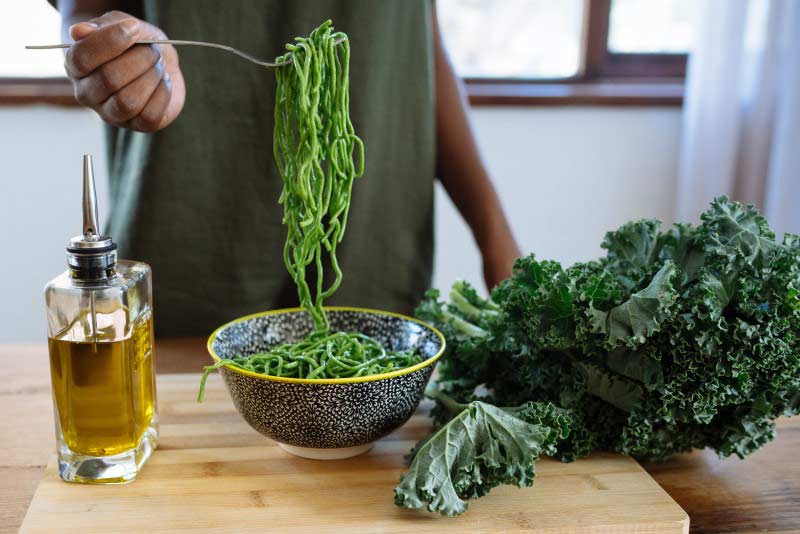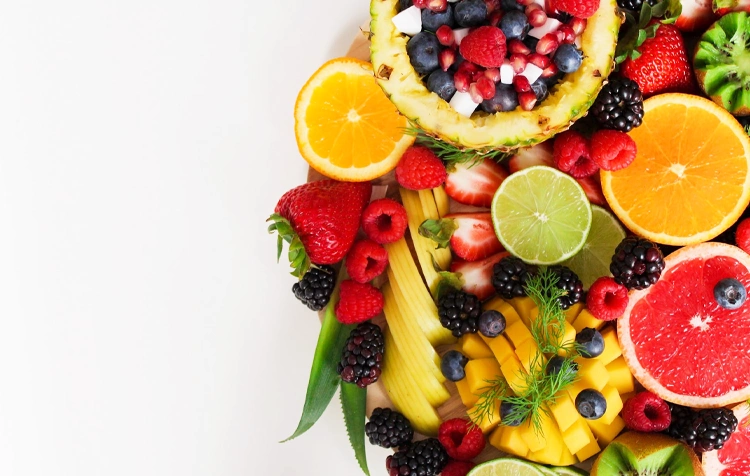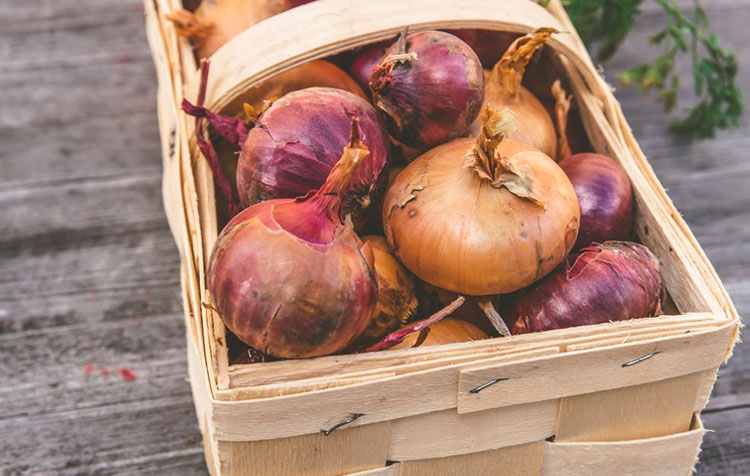You want to know more about vitamin C? Then you will find it here! I will now give you the most important information about the valuable, water-soluble vitamin, which is also called ascorbic acid.
We start with a short profile, continue with the intake, daily requirement, function, risk of overdose or deficiency, to the best sources of vitamin C and supplements. Finally, I'll introduce you to important info on what to look for in a plant-based diet regarding vitamin C.
Here is in advance a short Overview for you:
Notice: This article is not a substitute for medical advice, but provides general information about vitamin C only. Please consult your doctor if you feel unwell or want to prevent health problems with medical care.
VITAMIN C PROFILE AT A GLANCE
Assignment: Water soluble vitamins
Synonyms: Ascorbic acid, L-ascorbic acid, 3-oxo-L-gulonic acid-γ-lactone, E 300
Important for: Builds connective tissue, bones and teeth, antioxidant1
Daily requirement: 75-110 mg/day from the age of 19.2,3,4
Overdose: unlikely, maximum intake 2,000 mg3
Deficiency symptoms: including scurvy, poor wound healing, joint pain
Food: Acerola cherries, red peppers, parsley, citrus fruits, kale
Nutritional supplement: in the form of tablets, powder or drops
The anti-scorbut vitamin
Originally, vitamin C was also known as Anti-scorbut vitamin known. Scurvy, the seafarer's disease, used to be caused by the low vitamin C diet on ships. In 1795, the British Navy therefore stipulated that a ration of lemon juice should be distributed among the ship's crew of the Royal Navy every day.
Plants and most animals can synthesize the organic acid themselves. Humans, on the other hand, must take in vitamin C through plant foods. Thereby the Bioavailability of the vitamin is 80 to 100 percent when it is supplied through the diet.
However, when cooking with Preparation losses of 30 to 50 percent can be expected. The cooking process inactivates the water-soluble vitamin. In the end, it simply passes into the boiling water. Longer storage can also lead to a loss of vitamin content.
Good to know: Foods containing vitamin C should be stored for a short time and, above all, eaten raw. When heating, blanching for a short time is a good idea. The cooking water can then simply be reused, for example for cooking pulses or for a soup.
What is the daily requirement of vitamin C?

The intake recommendations for this valuable vitamin are the subject of controversial debate. Currently, the recommendations of nutrition societies are geared toward avoiding deficiency symptoms. However, it can also be quite sensible to take more vitamin C. As always, the reference values should therefore only be seen as a rough guide.
The Office of Dietary Supplements recommends that adult males 19 years of age and older consume a daily intake of 90 mg Vitamin C. Adult women are recommended a daily intake of 75 mg recommended.3 The European Food Safety Authority (EFSA) recommends a slightly higher intake, 110 mg for men and 95 mg for women.4
The feed recommendations of the German Society for Nutrition (DGE) are broken down by gender and age and are shown in mg/day in the following table2:
| Age | male | female |
| 1 to under 4 years | 20 | 20 |
| 4 to under 7 years | 30 | 30 |
| 7 to under 10 years | 45 | 45 |
| 10 to under 13 years | 65 | 65 |
| 13 to under 15 years | 85 | 85 |
| 15 to under 19 years | 105 | 90 |
| 19 years and older | 110 | 95 |
The three nutrition societies mentioned above give an increase in vitamin C intake as a recommendation for pregnant and breastfeeding women off.2,3,4
In addition, the requirement is increased by heavy physical exertion, high sweat losses, diabetes mellitus, alcohol abuse, medication, as well as smoking and environmental pollution. Smoking is recommended to increase the daily intake by 35-45 mg.2,3
What does the body need ascorbic acid for?
The essential vitamin acts mainly as a very powerful antioxidant and thus keeps the cells of the body healthy. It also works closely with the also antioxidant Vitamin E together by preventing lipid peroxidation and thus reducing the Cells protects.
The ascorbic acid is a Cofactor in the production of collagen and the synthesis of neurotransmitters and hormones. It also acts indirectly on the Fat metabolism as it is required for the production of the transporter carnitine, which is involved in fat burning. It is also required for the synthesis of peptide hormones, bile acid and cytochrome P450, which is needed for detoxification. Through the synthesis of interferon, furthermore, the Immune defense strengthened.
Another important point is the Increase the Absorption rate from Ironwhen foods containing iron and vitamin C are combined in a meal. What is equally particularly important nowadays is the anti-cancer effect of ascorbic acid and the Reduction of cardiovascular disease risk.3,5
According to studies, oxidative stress is increased by contraceptives such as the birth control pill, which leads to a higher risk of cardiovascular diseases. This can be counteracted by an increased intake of vitamins C and E.6
By increasing the excretion of uric acid, vitamin C also reduces the risk of developing gout.7
The Functions of vitamin C briefly summarized:
- Antioxidant and protection of cells
- Cofactor of many metabolic processes
- Immune defense
- Increase iron absorption
- Anti-cancer effect
- Reduced risk of suffering from cardiovascular diseases
- Reduces the risk of developing gout
Is there a risk of oversupply of vitamin C?
EFSA has not established a Tolerable Upper Intake Level (UL) for vitamin C due to its low toxicity.8 According to the DGE, gastrointestinal symptoms such as diarrhea can occur at intakes of 3,000 to 4,000 mg of vitamin C.1 The Office of Dietary Supplements mentions a UL of 2,000 mg, but at the same time mentions that it is little evidence of health risks of high dosages of ascorbic acid exist.3
Can ascorbic acid deficiency occur?
According to a statement by the German Society for Nutrition Germany is not a vitamin deficient country and the population is sufficiently supplied with vitamins.9 According to the National Consumption Study II, a large-scale nutrition study conducted in Germany from 2005 to 2007, however, 32 percent of men and 29 percent of women do not reach the recommended reference values for vitamin C intake.10 While this does not necessarily mean that these people are suffering from a deficiency, it also does not speak for an ideal nutrient supply.
Causes of deficiency are mainly due to an unbalanced diet with little fruit and vegetables. Other reasons are absorption disorders, for example due to gastrointestinal diseases or the intake of medication and/or the contraceptive pill. Furthermore, smokers, passive smokers, alcoholics and infants who are not breastfed belong to the Risk group.3
Symptoms of deficiency are bleeding gums, changes in the oral mucosa, susceptibility to infections, poor performance and susceptibility to stress. In severe cases tooth loss, disturbed wound healing or psychological disorders occur.
What foods are rich in vitamin C?
Ascorbic acid occurs mainly in Fruit and vegetables before. But even here there are big differences in the content. In the following table, I therefore present to you particularly good suppliers of vitamin C before:
- Acerola cherry (1700 mg per 100 gram)
- Sea buckthorn juice (260 mg per 100 gram)
- Parsley (160 mg per 100 gram)
- Red bell bell pepper (140 mg per 100 gram)
- Broccoli (110mg per 100 gram)
- Kale (100 mg per 100 gram)
- Strawberries (60 mg per 100 gram)
- Oranges, lemons (50 mg per 100 gram)
Other food groups such as legumes, cereals and dairy products, meat, and nuts and seeds contain hardly any significant amounts of vitamin C. Therefore a wholefood diet rich in fruits and vegetables essential for a good vitamin C supply.
Delicious Kale chips with paprika marinade for example, are a real vitamin C bomb. However, ascorbic acid is also often found in processed foods and is declared as E 300.
Good to know: The acerola cherry originates from America and was already valued there by indigenous peoples as a source of health.11 Acerola is unfortunately not available regionally, but it should not be missing from the list due to its gigantic content of ascorbic acid.

What do vegans need to pay attention to when it comes to vitamin C?
With regard to the supply of vitamin C, vegans tend to be better supplied than vegetarians or mixed dieters. This is because Ascorbic acid almost exclusively in fruits and vegetables and vegans logically eat particularly much of it. Therefore, vitamin C is also mentioned in the position paper of the DGE on vegan nutrition. not as potentially critical nutrients designated for vegans.12
Which dietary supplements are recommended?
For many people, supplementation is not necessary. However, there are special cases in which it may be useful to supplement ascorbic acid. These include, for example, people who, due to a Fructose intolerance consume little to no fruits and vegetables. In addition, targeted supplementation of vitamin C can help with a Iron deficiency be useful to increase iron absorption. For the risk groups mentioned above, supplementation could therefore make sense.
In this case I can Vitamin C capsules from organic acerola recommend. The Capsules you get here.*
As an all-rounder I can also give you Barley grass powder recommend. Two teaspoons already contain 15 mg ascorbic acid and many other vitamins and nutrients. You can simply dissolve the powder in water, mix it into smoothies, dressings, yogurt or muesli. Barley grass powder you get here.*
Tip: You can find even more info about vegan supplements in the article Nutritional supplementation for vegan diet.
FAQ: The most frequently asked questions about VITAMIN C
What foods are rich in vitamin C?
Notable amounts of vitamin C are only found in fruits and vegetables. Particularly high amounts of the valuable vitamin are found in red peppers, broccoli and kale.
What are the functions of vitamin C in the body?
Vitamin C is a valuable antioxidant that protects your cells. It also helps in metabolic processes, immune defense and cancer prevention. It also increases the absorption of iron.
Is vitamin C water-soluble or fat-soluble?
Vitamin C, also known as ascorbic acid, is a water-soluble vitamin.
What is high-dose vitamin C good for?
In high-dose vitamin C therapy, vitamin C is supplied to the body via infusions. This form of therapy is used in orthomolecular medicine, for example, for the treatment of girdle rot.
Is vitamin C heat resistant?
No, vitamin C is inactivated when heated. Therefore, you should eat foods containing vitamin C primarily raw or blanch them only briefly.
for sufficient vitamin C consume mainly FRUIT AND VEGETABLES
With a Diet rich in fruits and vegetables you can absorb a lot of the valuable, antioxidant nutrient. Especially when you are very stressed or exposed to many environmental stresses, a balanced diet with plenty of vitamin C and E is particularly important and valuable. With foods such as barley grass powder, sea buckthorn juice or acerola, you can even specifically increase your intake of ascorbic acid.
The best way to complement your healthy diet is with other health measures such as cold shower, much movement at the fresh air and Meditation. If you incorporate just a few of these health-promoting measures into your daily routine, you're guaranteed to notice many positive changes over time.
Feel free to use the comment function for questions, suggestions or criticism about this post on vitamin C.
All the best,

PS.: In our Nutrient database you will find even more information about all nutrients for a healthy diet. Next, for example, feel free to look directly at the article about Vitamin B6 on. Have fun!
References:
1 Deutsche Gesellschaft für Ernährung e. V.: Selected questions and answers on vitamin C. https://www.dge.de/wissenschaft/weitere-publikationen/faqs/vitamin-c/#c1474. [17.08.2021].
2 Deutsche Gesellschaft für Ernährung e. V.: Vitamin C, https://www.dge.de/wissenschaft/referenzwerte/vitamin-c/?L=0. [Aug. 17, 2021].
3 National Institutes of Health. Office of Dietary Supplements: Vitamin C. Fact Sheet for Health Professionals, https://ods.od.nih.gov/factsheets/VitaminC-HealthProfessional/. [17.08.2021].
4 European Food Safety Authority: Scientific Opinion on Dietary reference values for Vitamin C, https://efsa.onlinelibrary.wiley.com/doi/epdf/10.2903/j.efsa.2013.3418. [17.08.2021].
5 Center for Health: Vitamin C in the Fight Against Cancer, https://www.zentrum-der-gesundheit.de/ernaehrung/vitamine/vitamin-c-uebersicht/vitamin-c-gegen-krebs-ia. [17.08.2021].
6 F. Zal, Z. Mostafavi-Pour, F. Amini, A. Heidari (2012): Effect of vitamin E and C supplements on lipid peroxidation and GSH-dependent antioxidant enzyme status in the blood of women consuming oral contraceptives. Contraception. DOI: 10.1016/j.contraception.2011.11.006, Epub 2012 Apr 9. PMID: 22494786.
7 Zentrum der Gesundheit: Vitamin C - an all-round genius, https://www.zentrum-der-gesundheit.de/ernaehrung/vitamine/vitamin-c-uebersicht/vitamin-c. [17.08.2021].
8 European Food Safety Authority: Tolerable Upper Intake Levels for Vitamins and Minerals, https://www.efsa.europa.eu/sites/default/files/efsa_rep/blobserver_assets/ndatolerableuil.pdf. [17.08.2021].
9 A. Bechthold, V. Albrecht, E. Leschik-Bonnet, H. Heseker (2012): DGE Opinion: Assessment of vitamin supply in Germany. In: Ernährungsumschau 59 (2012), pp. 324-336. Online: https://www.ernaehrungs-umschau.de/fileadmin/Ernaehrungs-Umschau/pdfs/pdf_2012/07_12/EU07_2012_396_401.qxd.pdf. [17.08.21].
10 Max Rubner Institute. J. Möhring, H. F. Erbersdobler (2008). National consumption study II - Results report part 2. In Food Commodity Science For Beginners, (Springer), pp. 121-146. Online: https://www.mri.bund.de/de/institute/ernaehrungsverhalten/forschungsprojekte/nvsii/erg-verzehr-naehrstoffe. [17.08.2021].
11 Zentrum der Gesundheit: Acerola: The Natural Vitamin C, https://www.zentrum-der-gesundheit.de/ernaehrung/lebensmittel/obst-fruechte/acerola-kirsche. [17.08.2021].
12 Deutsche Gesellschaft für Ernährung e. V.: Supplement to the position of the German Nutrition Society regarding population groups with special nutritional needs, https://www.dge.de/wissenschaft/weitere-publikationen/dge-position/vegane-ernaehrung/?L=0 [Aug. 17, 2021].






